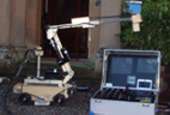 |
 |
||
| Nuclear Decommissioning Services Ltd | |||
Remotely Operated Systems

We have designed remotely operated vehicles for a number of establishments for various purposes. These are often required to work in particularly challenging environments. For instance, this might include underwater operations, constricted areas such as drains and ducts, and intense radiation fields. We can deploy remote sensing a wide variety of remote sensing instrumentation.
The ROV and control console shown here (right) were delivered to UKAEA for use in a high radiation environment. The sensor head was placed on a pan/tilt system. This embodied a camera, distance measuring laser and gamma probe.
These vehicles and instrumentation systems are built in-house and fully tested by our own experts.
LessRemote and Specialist Equipment Supply and Operation
- Specification and Manufacture of a Remove Survey Vehicle for D1204 Dounreay
- Specification of ROVs for work in D8550, D1207, D1211 and D1217
- Design, Development and Manufacture of a BNFL Radiological Drain Survey System
- Study/Specification for a Radiological Drain Survey System for UKAEA
- Implementation of remote survey on Dounreay contaminated drain
- ROV Survey of DFR vault, incl. SAM preparation
- Design and build of Tritium Sampling System
- Design and supply of particle filtration and grouting equipment
- Design, supply and operation of simple CCTV and radiological survey systems for DMTR
- Cleaning and Radiological/CCTV Survey of D1251 drains
- Design and supply of particle filtration and grouting equipment for D1251 Tanks
- Disposal of 34,000 sodium coupons, including equipment design, supply and operation, and all safety/operational documentation including Building Safety Case.
Specialist Equipment Supply and Operation

In addition to Remotely Operated Systems, NDSL can design, build and operate special equipment to deal with decommissioning problems, using innovative and effective, but often simple solutions.
For example, NDSL conducted an option study into the disposal of some 33,000 mildly radio-active, sodium-filled, stainless steel coupons.
Following successful trials, a highly cost-effective system was deployed to check each coupon for the presence of fuel or other rogue contents, to open the coupons and deposit them into nitrogen-filled drums for incineration. For more information please have a look at the Sodium Coupons.
The second photograph shows a tritium bubbler, designed and built by NDSL in response to a request from UKAEA for a system to measure the level of tritium in the gaseous extract system from the Dounreay Materials Test Reactor.
Sodium Coupons Disposal Less Back to Innovations
Sodium coupons are about 2" square in size, and consist of a stainless steel sleeve containing a small sodium tablet. They were used in small research reactors such as ZEBRA at Winfrith to allow trials with a variety fuel and coolant materials.
Over 300,000 such coupons were manufactured in total. Of these some 33,000 were stored at Winfrith having been used in ZEBRA and a much larger number are stored at Caderache in France where they have been used for similar experiments. They exhibit minimal levels of radioactivity, with the more significant hazard being the presence of sodium, which reacts explosively with water and will burn readily in the air. The coupons cannot be consigned to long term disposal intact; the contents must be made safe.

There are three identifiable stages that must be undertaken in the disposal of the coupons: their opening to expose the sodium tablets, the rendering safe of the sodium tablets, and the disposal of the ensuing waste materials including the stainless steel cases and the sodium products.
NDSL was asked by UKAEA at Winfrith to:
- conduct an option study into the safe disposal of the 33,000 Winfrith coupons;
- design, trial, supply and commission equipment for the opening of the coupons in conjunction with its subcontractor TFT;
- write the Safety Cases, Method Statements, Commissioning Schedules, etc. for the building and for the process;
- operate the special equipment to open all 33,215 coupons and deposit them in nitrogen-filled drums;
- arrange for the final disposal of the waste materials by Veolia ES Onyx.
Once the equipment and paperwork were in place, the coupon opening and disposal process were completed within less than three weeks.
The project was deemed to be a tremendous success by our client, UKAEA Winfrith.

Build and Commission
As well as the design of ventilation systems, NDSL also undertakes, with the assistance of subcontractors, the build, installation and commissioning of such systems. Recent examples include the Hunterston A CCP Bay ventilation system, and the design and commissioning of ventilation systems for a range of buildings at Dounreay, including the DFR NAK Disposal Plant and DMTR.
 'Cost Effective & Innovative' |
 |